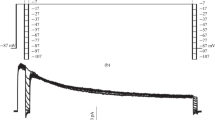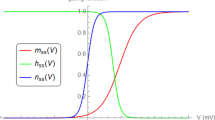Summary
-
1.
Voltage clamp experiments were carried out on single myelinated fibres of the frog to analyse the changes of the potassium conductance (g K ) resulting from variations of the external K-concentration ([K]0). The use ofg K is justified by the observation that instantaneous K-currents vary linearly withE despite asymmetries between [K]0 and [K]i.
-
2.
At constant membrane potential and for inward going currents,g K increases as a Michaëlian function of [K]0. We propose, therefore, that external K-ions bind specific membrane sites controllingg K . The apparent equilibrium constant (K app ) of the binding reaction decreases with depolarization following a double exponential function. The rate constants of this function depend on the external Ca-concentration.
-
3.
An empirical equation is derived which satisfactorily describes the variation ofg K as a function ofE and [K]0. The fact that either the increase in [K]0 or the membrane depolarization can lead to the opening of the channels is regarded as evidence that the binding of K to specific sites (“K-receptors”) is a necessary step for the formation of conducting channels. The affinity of the receptor-sites for K-ions depends on the electrical field in the membrane.
-
4.
K-free Ringer solutions markedly reduce the steady-state K-current and its rate of activation. These effects are not observed if the lack of potassium is compensated by addition of caesium. It is concluded that Cs can replace K at the sites controlling the formation of the channel.
-
5.
High external concentrations of Cs-ions reduce the inward K-currents when [K]0 is high and tend to increase outward K-currents, especially when [K]0 is low. These results are explained assuming that Cs-ions enter the channel with K-ions moving in single file. They stop the in-moving file when reaching a selectivity structure deeply located in the channel.
-
6.
The fraction of the membrane thickness (δ) at which Cs-ions occupy a blocking position in the K-channel, when K and Cs are present at high concentrations in the external medium, is estimated to be: δ=0.6. From this result, it is deduced that the voltagesensitive K-receptors are located in the external half of the membrane.
Similar content being viewed by others
References
Armstrong, C. M.: Potassium pores of nerve and muscle membranes. In: Membranes (G. Eisenman, ed.), Vol. 3, pp. 325–357. New York: Marcel Dekker, Inc. 1975
Armstrong, C. M., Hille, B.: The inner quaternary ammonium ion receptor in potassium channels of the node of Ranvier. J. Gen. Physiol.59, 388–400 (1972)
Begenisich, T., Stevens, C. F.: How many conductance states do potassium channels have? Biophys. J.15, 843–846 (1975)
Begenisich, T., De Weer, P.: Evidence for ionic inter-actions in the K-channel of squid axon. Biophys. J.17, 45a (1977)
Bergman, C.: Increase of sodium concentration near the inner surface of the nodal membrane. Pflügers Arch.317, 287–302 (1970)
Bezanilla, F., Armstrong, C. M.: Negative conductance caused by entry of sodium and cesium ions into the potassium channels of Squid axons. J. Gen. Physiol.60, 588–608 (1972)
Brismar, T.: Effects of ionic concentration on permeability properties of nodal membrane in myelinated nerve fibres ofXenopus laevis. Potential clamp experiments. Acta Physiol. Scand.87, 474–484 (1973)
Brismar, T., Frankenhaeuser, B.: The effect of calcium on the potassium permeability in the myelinated nerve fibres ofXenopus laevis. Acta Physiol. Scand.85, 237–241 (1972)
Carmeliet, E. E.: Chloride and potassium permeability in cardiac Purkinje fibres. Thesis, Faculty of Medicine, University of Louvain. Brussel: Presses Académiques Européennes Edit. 1961
Dodge, F. A.: A study of ionic permeability changes underlying excitation in myelinated nerve fibres of the frog. Ph. D. Thesis. The Rockefeller University. University Microfilm no. 64-7333. Michigan: Ann. Arbor 1963
Drouin, H., Neumcke, B.: Specific and unspecific charges at the sodium channel of nerve membrane. Pflügers Arch.351, 207–229 (1974)
Dubois, J. M., Bergman, C.: Late sodium current in the node of Ranvier. Pflügers Arch.357, 145–148 (1975a)
Dubois, J. M., Bergman, C.: Cesium induced rectifications in frog myelinated fibres. Pflügers Arch.355, 361–364 (1975b)
Dubois, J. M., Bergman, C.: Potassium accumulation in the perinodal space of frog myelinated axons. Pflügers Arch.358, 111–124 (1975c)
Eyring, H., Eyring, E. M.: Modern chemical kinetics. Chap. 4. New York: Reinhold Comp 1963
Frankenhaeuser, B.: Instantaneous potassium current in myelinated nerve fibres ofXenopus laevis. J. Physiol. (Lond.)160, 46–53 (1962a)
Frankenhaeuser, B.: Potassium permeability in myelinated nerve fibres ofXenopus laevis. J. Physiol. (Lond.)160, 54–61 (1962b)
Frankenhaeuser, B., Hodgkin, A. L.: The action of calcium on the electrical porperties of squid axons. J. Physiol. (Lond.)137, 218–244 (1957)
Ginsburg, S., Noble, D.: Use of current-voltage diagrams in locating peak energy barriers in cell membranes. J. Membr. Biol.29, 211–230 (1976)
Goldman, D. E.: Potential, impedance and rectification in membranes. J. Gen. Physiol.27, 37–60 (1943)
Hille, B.: The selective inhibition of delayed potassium currents in nerve by tetraethylammonium ion. J. Gen. Physiol.50, 1287–1302 (1967)
Hille, B.: Potassium channels in myelinated nerve: selective permeability to small cations. J. Gen. Physiol.61, 669–686 (1973)
Hille, B.: Ionic selectivity of Na and K channels of nerve membranes. In: Membranes (G. Eisenman, ed.) Vol. 3, pp. 256–323. New York: Marcel Dekker, Inc. 1975
Hodgkin, A. L., Katz, B.: The effect of sodium ions on the electrical activity of the giant axon of the Squid. J. Physiol. (Lond.)108, 37–77 (1949)
Hodgkin, A. L., Keynes, R. D.: The potassium permeability of a giant nerve fibre. J. Physiol. (Lond.)128, 61–88 (1955)
Keynes, R. D.: The nervous system (D. B. Tower, ed.) Vol. 1, pp. 165–175. New York: Raven Press 1975
Meves, H.: The effect of holding potential on the asymmetry currents in squid giant axons. J. Physiol. (Lond.)243, 847–867 (1974)
Mozhayeva, G. N., Naumov, A. P.: Effect of surface charge on the steady-state potassium conductance of nodal membrane. Nature (Lond.)228, 164–165 (1970)
Nonner, W.: A new voltage clamp method for Ranvier nodes. Pflügers Arch.309, 176–192 (1969)
Woodhull, A. M.: Ionic blockage of sodium channels in nerve. J. Gen. Physiol.61, 687–708 (1973)
Author information
Authors and Affiliations
Additional information
Supported by grants of the C.N.R.S. and D.G.R.S.T
Rights and permissions
About this article
Cite this article
Dubois, J.M., Bergman, C. The steady-state potassium conductance of the ranvier node at various external K-concentrations. Pflugers Arch. 370, 185–194 (1977). https://doi.org/10.1007/BF00581693
Received:
Issue Date:
DOI: https://doi.org/10.1007/BF00581693




